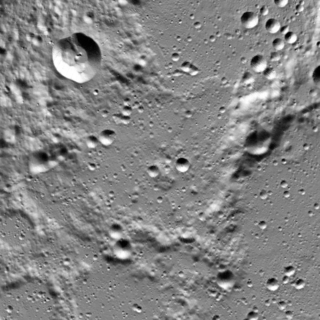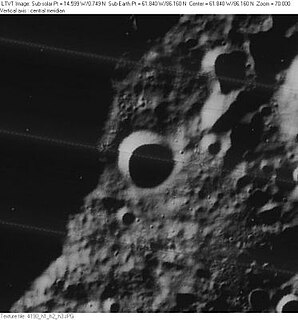
Philipp Eduard Anton von Lenard was a Hungarian-born German physicist and the winner of the Nobel Prize for Physics in 1905 for his work on cathode rays and the discovery of many of their properties. One of his most important contributions was the experimental realization of the photoelectric effect. He discovered that the energy (speed) of the electrons ejected from a cathode depends only on the wavelength, and not the intensity, of the incident light.

Euclides is a small lunar impact crater located near the eastern edge of Oceanus Procellarum, about 30 kilometers to the west of the Montes Riphaeus mountains. The mare in the vicinity is devoid of significant craters, but to the west is an area of low rises. The crater is named after the Greek mathematician Euclid.

Fauth is a small double-crater located at the edge of the rough southern ramparts of the prominent ray crater Copernicus on the Moon. It lies in the Mare Insularum, to the northeast of the crater Reinhold. The crater is named after German selenographer Philipp Johann Heinrich Fauth.

Apollo is an enormous impact crater located in the southern hemisphere on the far side of the Moon. This formation dwarfs the large crater Oppenheimer that is located next to the western rim. The crater Barringer lies across the northern wall. To the southeast is the crater Anders, and Kleymenov is just to the east of the rim.

Byrd is an irregular lunar impact crater that is located near the north pole of the Moon. The north rim of Byrd is nearly connected to the crater Peary, a formation that is adjacent to the pole. The smaller crater Gioja is attached to the remains of the southwest rim.

Von Kármán is a large lunar impact crater that is located in the southern hemisphere on the far side of the Moon. The crater is about 180 km (110 mi) in diameter and lies within an immense impact crater known as the South Pole–Aitken basin of roughly 2,500 km (1,600 mi) in diameter and 13 km (8.1 mi) deep. Von Kármán is the site of the first soft-landing on the lunar far side by the Chinese Chang'e 4 spacecraft on 3 January 2019.

de Gerlache is a lunar impact crater that is located along the southern limb of the Moon, within a crater diameter of Shackleton at the south pole. From the Earth this crater is seen from the edge, and it lies in perpetual darkness. Thus little or no detail can be seen of this crater, other than the edge of the rim. However, the crater is clearly visible in Earth-based radar images. The crater is roughly circular, with some slight wear. No craters of note overlie the rim, although some formations may be attached to the southern and western edges.

Stark is a lunar impact crater on the far side of the Moon. It lies to the southeast of the prominent crater Tsiolkovskiy, and north of Subbotin.

The topography of the Moon is the mapping of the Moon's surface and the study of its shape. It has been measured by the methods of laser altimetry and stereo image analysis, including data obtained during several missions. The most visible topographical feature is the giant far side South Pole-Aitken basin, which possesses the lowest elevations of the Moon. The highest elevations are found just to the northeast of this basin, and it has been suggested that this area might represent thick ejecta deposits that were emplaced during an oblique South Pole-Aitken basin impact event. Other large impact basins, such as the maria Imbrium, Serenitatis, Crisium, Smythii, and Orientale, also possess regionally low elevations and elevated rims.

Aepinus is a small lunar impact crater located along the northern lunar limb, close to the north pole of the Moon. To the south east is the prominent crater Hermite.

Braude is a lunar impact crater located on the far side of the Moon. The crater is named after radio astronomer Semion Braude. The crater was adopted by the IAU in 2009. The nearest major feature is the Schrödinger crater. Also located nearby is the Wiechert crater, which is located less than 170 kilometers from the southern pole.
Fibiger is a lunar impact crater located on the lunar near side near the northern pole. The nearest major feature is the Byrd crater. The crater was adopted and named after Danish pathologist Johannes Andreas Grib Fibiger in 2009 by the IAU. Located just north of Fibiger are craters Erlanger and Peary, which are 9.9 km and 73 km in diameter, respectively.

Florey is a lunar impact crater on the lunar near side near the northern pole. Florey is directly adjacent to Byrd crater to the Southeast and Peary crater to the North. The crater is named after Australian scientist Howard Florey. The crater was named by the IAU in 2009.

Gore is a lunar impact crater located on the lunar near side near the northern pole. Major nearby features include Florey crater to the Southeast, Peary crater to the East-Northeast, and Byrd crater to the Southeast. The crater was adopted and named after John Ellard Gore by the IAU in 2009.
Grignard is a lunar impact crater on the lunar near side near the northern pole. The crater is located Northeast of Sylvester crater and is directly adjacent to the Hermite crater. The crater was adopted and named after French chemist Victor Grignard by the IAU in 2009.
Haskin is a lunar impact crater located on the lunar far side near the northern pole. The crater is located Southwest of the Hevesy crater and the Plaskett crater; the latter of which is located directly adjacent to the large Rozhdestvenskiy crater. The crater was adopted and named after American chemist Larry Haskin by the IAU in 2009.

Hevesy is a lunar impact crater located on the lunar far side near the northern pole. The crater is located in between craters Plaskett and Haskin. The large Rozhdestvenskiy crater is located to the Northeast. Hevesy was adopted and named after Hungarian chemist George de Hevesy by the IAU in 2009.
Houssay is a lunar impact crater located on the lunar far side near the northern pole. The crater is located to the northeast of and directly adjacent to crater Nansen. Houssay was adopted and named after the Argentinian physiologist Bernardo Houssay by the IAU in 2009.
Kuhn is a lunar impact crater located on the lunar far side near the Northern lunar pole. The crater is located east of the Kocher crater, Southeast of the prominent Ashbrook crater and just north of the southern lunar pole. Kuhn was adopted and named after German chemist Richard Kuhn by the IAU in 2008.

Cai Lun is a lunar impact crater located on the lunar far side near the northern pole. The crater is located in between the prominent craters Haskin and Nansen. Cai Lun was adopted and named after Chinese inventor Cai Lun by the IAU in August, 2010.















